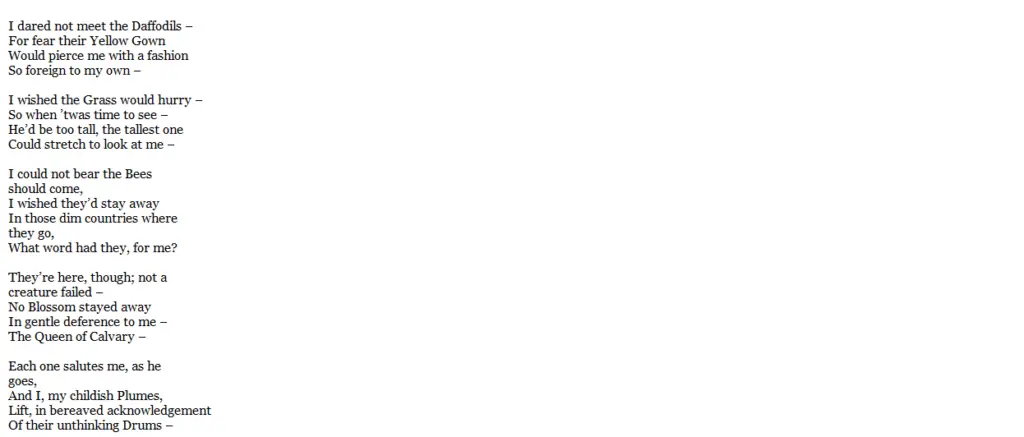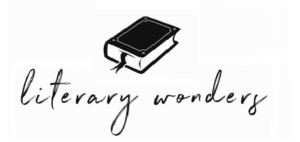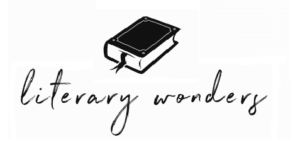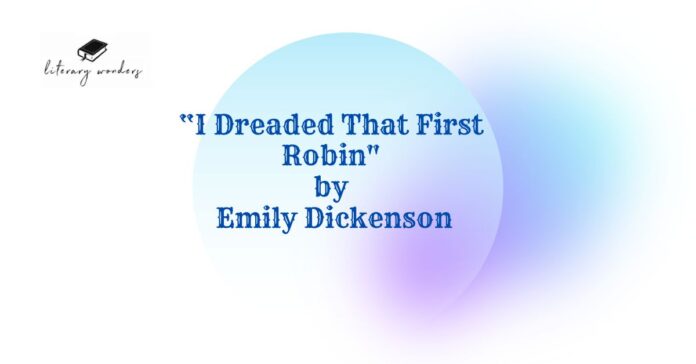“I Dreaded That First Robin” by Emily Dickenson

Summary of the Poem, “I Dreaded That First Robin”
“I Dreaded That First Robin” is a powerful poem composed by Emily Dickenson, a renowned American author and poet. The speaker’s anxiety about the coming of spring is expressed in the poem. Having the change that the arrival of spring brings to the world in mind, Emily wrote this poem. The poem, however, became highly recognized because it demonstrates how reluctant people may be.
The first robin that flies by the speaker in the poem represents her staunch opposition to the coming of spring. Although she initially disliked the bird, she has come to accept its presence as a sign that spring has arrived. The speaker wants to stay away from the sights and sounds of spring, particularly the bee buzzing and the bright daffodils. She expresses resistance to spring’s entrance by wishing for the grass to get thick and cover the blossoms. The speaker is greeted by the robin, daffodils, and bees as spring finally arrives in spite of her trepidation. The speaker receives and acknowledges the season’s greetings with a sense of hardship or loss.
Major Themes in The Poem “I Dreaded That First Robin”
Major themes in the poem include acceptance, fear, uncertainty, change, and change. The poem’s structure reveals that the speaker’s emotions are clearly in contrast, with one half of the poem showing uncertainty and reluctance approaching spring and the other half demonstrating acceptance and acknowledgment. She initially fears spring’s shift in seasons since it denotes aging and the certainty of death.
Despite her apprehension, she eventually comes to the conclusion that change is a necessary and inevitable element of life. She thus exhibits a significant mental shift in the poem’s second part, comfortably embracing the demands of the new season.
The poem also addresses issues of mortality and the fear of dying. The use of the term “dreaded” conveys apprehension and doubt about what the coming of spring will bring. It may imply an unwillingness to accept change or uncertainty.
Analysis of Poetic Devices Used in “I Dreaded That First Robin”
Authors employ literary methods to give their writing depth, significance, and intrigue. This poem’s intended impact is enhanced by the literary components added by Emily Dickenson. The following is an analysis of the literary devices used in this poem.
- Assonance: Assonance is the repeating of vowel sounds within a single line, such as the vowel sound of “had the power to mangle me” and the vowel sound “I’m accustomed to Him grown.”
- Anaphora: In some passages, a word or phrase is repeated in the first section of the verse. In the poem’s fifth stanza, Emily uses the pronoun “I” twice to underline her points, such as;
“I could not bear the Bees should come,
I wished they’d stay away
In those dim countries where they go,
What word had they, for me?”
- Alliteration: Alliteration is the rapid occurrence of identical consonant sounds within the same line, such as the sound of /w/ in “What word had they” and the sound of /t/ in “too tall, the tallest one.”
- Consonance: Consonance is the repeating of consonant sounds inside a single line, such as the consonant sound /t/ in “In those dim countries where they go” and the consonant sound /r/ in “They’re here, though; not a creature failed.”
- Imagery: Using imagery, authors can influence how readers experience things using all five senses. In this poem, Emily Dickinson uses images like “Lift, in bereaved acknowledgment,” “In those dim countries where they go,” and “Not all Pianos in the Woods.
- Metaphor: This figure of speech makes an implicit comparison between two things that are fundamentally unrelated. In order to demonstrate how the change in weather affects humans and other creatures equally, the author used change as an extended metaphor in the poem.
- Symbolism: Symbolism is the use of symbols to represent concepts and traits by giving them meanings that are symbolic rather than literal. Worry, fear, resistance, change, and acceptance are all used as symbols in the poem.
The research demonstrates that the writer was able to express her thoughts and feelings in an excellent way, thanks to these devices.
Poetic Devices Used in The Poem
Poetic devices, like literary devices, are tools that help the poet create the right tone and structure for their work. The following is a study of the poem’s poetic devices.
- Vocabulary: The poem uses a descriptive vocabulary with rhetorical tactics, symbolism, and powerful imagery.
- Free Verse: A form of poetry without rhyme or meter is known as free verse. There is no set rhyme or meter in this free verse poem.
- Quatrain: A quatrain is a four-lined stanza that was originally used in Persian poetry. Here, each stanza is a quatrain, just like the first and second ones, like;
- Stanza: A stanza is a grouping of lines into a poem. This poem has seven stanzas, each of which has four lines.
Suggested Readings
Analysis of “In Flanders Fields” by John McCrae
Analysis of A Portrait of the Artist as a Young Man by James Joyce










